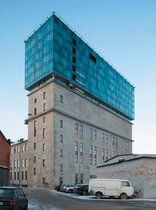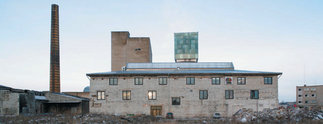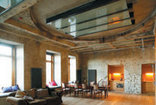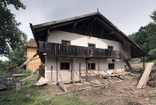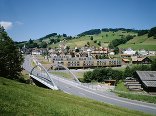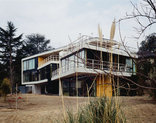Bauwerk
Fahle House
KOKO Arhitektid - Tallinn (EW) - 2007

Apartment building
KOKO architects have placed a glass box on top of the Fahle building, symbolizing its conversion from paper to lifestyle factory.
31. März 2007 - Triin Ojari
The Fahle building, a former paper factory named after its onetime owner, is perched on one of the highest points in Tallinn, right at the gates to the city, on the main road to the airport. It has become the city’s first large-scale example of industrial rebirth, with lofts, restaurants, clubs and now, towering over all this, a new glass box with apartments. More than anything else, it is symptomatic of the current frantic building boom in Tallinn, of the rampant daring of developers, of attempts by real-estate sharks to capture market trends and to sell the kudos and added value of an entire living environment.
The Fahle factory has become a significant setting in the development of modern Estonian architecture. Six years ago, a group of young architects organized a brainstorming session here. They wanted the abandoned factory, with its mysterious corners, industrial mega-space and countless corridors, to become Tallinn’s very own Culture Factory: a 24/7 city-like venue for living, creating and consuming, a place where you can forget that, somewhere, boring suburbs and supermarkets still exist. All sorts of studios and galleries were supposed to take up residence in the complex; both the Estonian Academy of Arts and the best avant-garde theatre wanted to move in, feeding on the synergy generated by co-existence and popular industrial romance. They saw culture in terms of post-capitalism versus industry, the pillar of „old“ capitalism.
But the dream of synergy and spectacle was not to be. Today, none of the original candidates has moved into the paper factory on the hill. Nevertheless, at least one good art gallery has set up shop behind the limestone walls, and a television station has settled, as yet somewhat shakily, beneath its chimney. A posh lighting shop opened in the building opposite and at anonther place in the labyrinthic complex you can play badminton or lie under a fake sun.
Reconstructed according to a design by KOKO architects, the Fahle building, with its restaurant floor, offices and choice of apartments, is in fact the first step in the reinvigoration of the area. Architecturally, the objective is clear: to emphasize the imposing factory building on top of the tall hill by adding a new layer to this landmark, a fashion statement in the form of a sexy glass building overlooking the city. The 14-storey structure does not try to blend in or to hide its modern appearance. It is a fitting apotheosis for what was, until recently, a heap of crumbling limestone walls.
In the United States, this phenomenon of revamped industrial buildings began some decades ago, when the new middle-class became tired of suburban life and started to move back to the city centres. The rebirth of former industrial areas was an important part of revitalizing city life by repopulating the city. „Loft living“ became the new lifestyle for the emerging, fashion-conscious generation and a successful real-estate product. So successful that there is now a shortage of factory buildings suitable for conversion and developers have taken to building brand new loft buildings.
The story conjured up in that cold cavernous paper factory on the hill six years ago, the story of culture as symbol and the new motor for urban renewal, was a retelling of NYC’s 1960s SoHo – a rundown, low-rent area populated by artists and small businesses. In the next two decades, as the old industrial buildings became successful development projects, the „authentic“ bohemian atmosphere began to be „packaged“ into luxury studio apartments – a lifestyle product for the wealthy. Of course, in the process, the original inhabitants of the area were banished.
In Tallinn, in the absurdity of the Soviet period, the authorities kept factories working in the city centre (land did not cost a thing back then and the planned economy ruled) and built „official“ lofts for artists in the grey concrete-slab suburbs. Studio and factory apartments, eye-catching architectural solutions and city living as sales strategy, have only now infiltrated the vocabulary of local real-estate developers. Yet the best views in the glass apartment box cost 3500 euros a square metre (there are only few apartments still available!) so who will move in will largely be determined by the size of their wallet.
Dutch architect Adriaan Geuze has said that what makes old industrial buildings exciting is the sense of freedom, even rebellion that overcomes the new inhabitants. „Most likely the buildings will become better, if they are not planned for a certain function, if the building and the function must adjust to one another,“ he says. It seems that one of the most attractive examples of such mutual re-discovery and co-existence has now been born in Tallinn.
The Fahle factory has become a significant setting in the development of modern Estonian architecture. Six years ago, a group of young architects organized a brainstorming session here. They wanted the abandoned factory, with its mysterious corners, industrial mega-space and countless corridors, to become Tallinn’s very own Culture Factory: a 24/7 city-like venue for living, creating and consuming, a place where you can forget that, somewhere, boring suburbs and supermarkets still exist. All sorts of studios and galleries were supposed to take up residence in the complex; both the Estonian Academy of Arts and the best avant-garde theatre wanted to move in, feeding on the synergy generated by co-existence and popular industrial romance. They saw culture in terms of post-capitalism versus industry, the pillar of „old“ capitalism.
But the dream of synergy and spectacle was not to be. Today, none of the original candidates has moved into the paper factory on the hill. Nevertheless, at least one good art gallery has set up shop behind the limestone walls, and a television station has settled, as yet somewhat shakily, beneath its chimney. A posh lighting shop opened in the building opposite and at anonther place in the labyrinthic complex you can play badminton or lie under a fake sun.
Reconstructed according to a design by KOKO architects, the Fahle building, with its restaurant floor, offices and choice of apartments, is in fact the first step in the reinvigoration of the area. Architecturally, the objective is clear: to emphasize the imposing factory building on top of the tall hill by adding a new layer to this landmark, a fashion statement in the form of a sexy glass building overlooking the city. The 14-storey structure does not try to blend in or to hide its modern appearance. It is a fitting apotheosis for what was, until recently, a heap of crumbling limestone walls.
In the United States, this phenomenon of revamped industrial buildings began some decades ago, when the new middle-class became tired of suburban life and started to move back to the city centres. The rebirth of former industrial areas was an important part of revitalizing city life by repopulating the city. „Loft living“ became the new lifestyle for the emerging, fashion-conscious generation and a successful real-estate product. So successful that there is now a shortage of factory buildings suitable for conversion and developers have taken to building brand new loft buildings.
The story conjured up in that cold cavernous paper factory on the hill six years ago, the story of culture as symbol and the new motor for urban renewal, was a retelling of NYC’s 1960s SoHo – a rundown, low-rent area populated by artists and small businesses. In the next two decades, as the old industrial buildings became successful development projects, the „authentic“ bohemian atmosphere began to be „packaged“ into luxury studio apartments – a lifestyle product for the wealthy. Of course, in the process, the original inhabitants of the area were banished.
In Tallinn, in the absurdity of the Soviet period, the authorities kept factories working in the city centre (land did not cost a thing back then and the planned economy ruled) and built „official“ lofts for artists in the grey concrete-slab suburbs. Studio and factory apartments, eye-catching architectural solutions and city living as sales strategy, have only now infiltrated the vocabulary of local real-estate developers. Yet the best views in the glass apartment box cost 3500 euros a square metre (there are only few apartments still available!) so who will move in will largely be determined by the size of their wallet.
Dutch architect Adriaan Geuze has said that what makes old industrial buildings exciting is the sense of freedom, even rebellion that overcomes the new inhabitants. „Most likely the buildings will become better, if they are not planned for a certain function, if the building and the function must adjust to one another,“ he says. It seems that one of the most attractive examples of such mutual re-discovery and co-existence has now been born in Tallinn.
Für den Beitrag verantwortlich: A10
Ansprechpartner:in für diese Seite: Hans Ibelings
